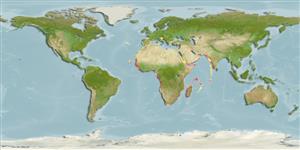Elasmobranchii (tubarões e raias) (sharks and rays) >
Myliobatiformes (Stingrays) >
Dasyatidae (Stingrays) > Dasyatinae
Etymology: Dasyatis: Greek, dasys = rough, dense (Ref. 45335).
More on author: Steindachner.
Environment: milieu / climate zone / depth range / distribution range
Ecologia
marinhas demersal; intervalo de profundidade 12 - 65 m (Ref. 4438). Tropical; 37°N - 36°S, 18°W - 35°E
Eastern Atlantic and Mediterranean Sea: Central to South Eastern Atlantic: Morocco, Mauritania to Congo (Ref. 33465) to Natal, South Africa (Ref. 5578); Mediterranean Sea: the records are patchy along the northern coast of Africa, and in Aegean Sea and Levantine Basin, most likely due to misidentification with other Dasyatidae spp. (Ref. 122045 and others cited).
Tamanho / Peso / Idade
Maturity: Lm ? range ? - ? cm
Max length : 74.5 cm TL macho/indeterminado; (Ref. 123700)
Descrição breve
Chaves de identificação | Morfologia | Morfometria
Espinhos dorsais (total) : 0. Conspicuous bright blue blotches and branching lines on a golden brown disc; snout and disc angular, and tail less than twice body length with a short upper caudal finfold, and a longer lower one falling far in front of tail tip; disc without thorns; usually one sting (Ref. 5578). Underside white, tail darker and without bands (Ref. 5578).
Close inshore, found on sandy beaches and in shallow bays (Ref. 5578), sometimes near rocky reefs (Ref. 12951). Found in deeper offshore areas during the winter season (Ref. 12951). Feeds on crabs, mantis shrimps, amphipods, worms, and fishes (Ref. 12951). Ovoviviparous (Ref. 50449). Minimum depth reported from Ref. 4438. Disc width measures 30 cm. Its thorny, venomous hooks can cause painful injuries (Ref. 5377).
Life cycle and mating behavior
Maturidade | Reprodução | Desova | Ovos | Fecundidade | Larvas
Exhibit ovoviparity (aplacental viviparity), with embryos feeding initially on yolk, then receiving additional nourishment from the mother by indirect absorption of uterine fluid enriched with mucus, fat or protein through specialised structures (Ref. 50449). With 1 to 4 in a litter (Ref. 12951). Distinct pairing with embrace (Ref. 205).
Cowley, P.D. and L.J.V. Compagno, 1993. A taxonomic re-evaluation of the blue stingray from southern Africa (Myliobatiformes: Dasyatidae). S. Afr. J. Mar. Sci. 13:135-149. (Ref. 33465)
Categoria na Lista Vermelha da IUCN (Ref. 130435: Version 2024-1)
Ameaça para o homem
Harmless
Utilização humana
Pescarias: sem interesse; peixe desportivo: sim
Ferramentas
Relatórios especiais
Descarregue XML
Fontes da internet
Estimates based on models
Preferred temperature (Ref.
123201): 20.6 - 28.1, mean 26.3 °C (based on 164 cells).
Phylogenetic diversity index (Ref.
82804): PD
50 = 0.5002 [Uniqueness, from 0.5 = low to 2.0 = high].
Bayesian length-weight: a=0.00372 (0.00177 - 0.00779), b=3.12 (2.94 - 3.30), in cm total length, based on LWR estimates for this species & (Sub)family-body (Ref.
93245).
Nível Trófico (Ref.
69278): 3.6 ±0.53 se; based on food items.
Resiliência (Ref.
120179): Muito baixo, tempo mínimo de duplicação da população maior que 14 anos (Fec=1-4).
Fishing Vulnerability (Ref.
59153): Moderate to high vulnerability (50 of 100).
